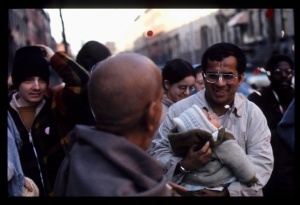CC Madhya 4.106 (1975): Difference between revisions
(Vanibot #0027: CCMirror - Mirror CC's 1996 edition to form a basis for 1975) |
(Vanibot #0020: VersionCompareLinker - added a link to the Version Compare feature) |
||
| Line 2: | Line 2: | ||
<div style="float:left">'''[[Sri Caitanya-caritamrta (1975)|Śrī Caitanya-caritāmṛta (1975)]] - [[CC Madhya (1975)|Madhya-līlā]] - [[CC Madhya 4 (1975)|Chapter 4: Śrī Mādhavendra Puri's Devotional Service]]'''</div> | <div style="float:left">'''[[Sri Caitanya-caritamrta (1975)|Śrī Caitanya-caritāmṛta (1975)]] - [[CC Madhya (1975)|Madhya-līlā]] - [[CC Madhya 4 (1975)|Chapter 4: Śrī Mādhavendra Puri's Devotional Service]]'''</div> | ||
<div style="float:right">[[File:Go-previous.png|link=CC Madhya 4.105 (1975)|Madhya-līlā 4.105]] '''[[CC Madhya 4.105 (1975)|Madhya-līlā 4.105]] - [[CC Madhya 4.107 (1975)|Madhya-līlā 4.107]]''' [[File:Go-next.png|link=CC Madhya 4.107 (1975)|Madhya-līlā 4.107]]</div> | <div style="float:right">[[File:Go-previous.png|link=CC Madhya 4.105 (1975)|Madhya-līlā 4.105]] '''[[CC Madhya 4.105 (1975)|Madhya-līlā 4.105]] - [[CC Madhya 4.107 (1975)|Madhya-līlā 4.107]]''' [[File:Go-next.png|link=CC Madhya 4.107 (1975)|Madhya-līlā 4.107]]</div> | ||
{{CompareVersions|CC|Madhya 4.106|CC 1975|CC 1996}} | |||
{{RandomImage}} | {{RandomImage}} | ||
==== TEXT 106 ==== | ==== TEXT 106 ==== | ||
| Line 11: | Line 10: | ||
<div class="verse"> | <div class="verse"> | ||
:gopāla kahe, purī āmāra tāpa nāhi yāya | :gopāla kahe, purī āmāra tāpa nāhi yāya | ||
:malayaja-candana | :malayaja-candana lepa', tabe se juḍāya | ||
</div> | </div> | ||
| Line 18: | Line 17: | ||
<div class="synonyms"> | <div class="synonyms"> | ||
gopāla—the Deity of Gopāla; kahe—said; purī—My dear Mādhavendra Purī; āmāra—My; tāpa—body temperature; nāhi—does not; yāya—go away; malayaja-candana—sandalwood produced in the Malaya Hills; | gopāla—the Deity of Gopāla; kahe—said; purī—My dear Mādhavendra Purī; āmāra—My; tāpa—body temperature; nāhi—does not; yāya—go away; malayaja-candana—sandalwood produced in the Malaya Hills; lepa'-smear over the body; tabe—then; se—that; juḍāya—cools. | ||
</div> | </div> | ||
| Line 25: | Line 24: | ||
<div class="translation"> | <div class="translation"> | ||
In his dream, Mādhavendra Purī saw Gopāla, who said, | In his dream, Mādhavendra Purī saw Gopāla, who said, "My bodily temperature still has not decreased. Please bring sandalwood from the Malaya province and smear the pulp over My body to cool Me. | ||
</div> | </div> | ||
| Line 32: | Line 31: | ||
<div class="purport"> | <div class="purport"> | ||
The Deity of Gopāla had been buried within the jungle for many years, and although He was installed and was offered thousands of pots of water, He still felt very hot. He therefore asked Mādhavendra Purī to bring sandalwood from the Malaya province. Sandalwood produced in Malaya is very popular. That province is situated on the western ghāṭa, and the hill Nīlagiri is sometimes known as Malaya Hill. The word malaya-ja is used to indicate the sandalwood produced in Malaya | The Deity of Gopāla had been buried within the jungle for many years, and although He was installed and was offered thousands of pots of water, He still felt very hot. He therefore asked Mādhavendra Purī to bring sandalwood from the Malaya province. Sandalwood produced in Malaya is very popular. That province is situated on the western ghāṭa, and the hill Nīlagiri is sometimes known as Malaya Hill. The word malaya-ja is used to indicate the sandalwood produced in the Malaya province. Sometimes the word Malaya refers to the modern country of Malaysia. Formerly this country also produced sandalwood, but now they have found it profitable to produce rubber trees. Although the Vedic culture was once prevalent in Malaysia, now all the inhabitants are Muslims. The Vedic culture is now lost in Malaysia, Java and Indonesia. | ||
</div> | </div> | ||
Latest revision as of 17:25, 27 January 2020

A.C. Bhaktivedanta Swami Prabhupada
TEXT 106
- gopāla kahe, purī āmāra tāpa nāhi yāya
- malayaja-candana lepa', tabe se juḍāya
SYNONYMS
gopāla—the Deity of Gopāla; kahe—said; purī—My dear Mādhavendra Purī; āmāra—My; tāpa—body temperature; nāhi—does not; yāya—go away; malayaja-candana—sandalwood produced in the Malaya Hills; lepa'-smear over the body; tabe—then; se—that; juḍāya—cools.
TRANSLATION
In his dream, Mādhavendra Purī saw Gopāla, who said, "My bodily temperature still has not decreased. Please bring sandalwood from the Malaya province and smear the pulp over My body to cool Me.
PURPORT
The Deity of Gopāla had been buried within the jungle for many years, and although He was installed and was offered thousands of pots of water, He still felt very hot. He therefore asked Mādhavendra Purī to bring sandalwood from the Malaya province. Sandalwood produced in Malaya is very popular. That province is situated on the western ghāṭa, and the hill Nīlagiri is sometimes known as Malaya Hill. The word malaya-ja is used to indicate the sandalwood produced in the Malaya province. Sometimes the word Malaya refers to the modern country of Malaysia. Formerly this country also produced sandalwood, but now they have found it profitable to produce rubber trees. Although the Vedic culture was once prevalent in Malaysia, now all the inhabitants are Muslims. The Vedic culture is now lost in Malaysia, Java and Indonesia.